Investigating Performance of Multi-Threading on Zen 3 and AMD Ryzen 5000
by Dr. Ian Cutress on December 3, 2020 10:00 AM EST- Posted in
- CPUs
- AMD
- Zen 3
- X570
- Ryzen 5000
- Ryzen 9 5950X
- SMT
- Multi-Threading
Power Consumption, Temperature
Two other arguments for having SMT enabled or disabled comes down to power consumption and temperature.
With SMT enabled, the core utilization is expected to be higher, with more instructions flowing through and being processed per cycle. This naturally increases the power requirements on the core, but might also reduce the frequency of the core. The trade-off is meant to be that the work going through the core should be more than enough to make up for extra power used, or any lower frequency. The lower frequency should enable a more efficient throughput, assuming the voltage is adjusted accordingly.
This is perhaps where AMD and Intel differ slightly. Intel’s turbo frequency range is hard-bound to specific frequency values based on core loading, regardless of how many threads are active or how many threads per core are active. The activity is a little more opportunistic when we reach steady state power, although exactly how far down the line that is will depend on what the motherboard has set the power length to. AMD’s frequency is continually opportunistic from the moment load is applied: it obviously scales down as more cores are loaded, but it will balance up and down based on core load at all times. On the side of thermals, this will depend on the heat density being generated in each core, but this also acts as a feedback loop into the turbo algorithm if the power limit has not been reached.
For our analysis here, we’ve picked two benchmarks. Agisoft, which is a variable threaded test performs practically the same with SMT On/Off, and 3DPMavx, a pure MT test which gets the biggest gain from SMT.
Agisoft
Photoscan from Agisoft is a 2D image to 3D model creator, using dozens of high-quality 2D images to generate related point maps to form a 3D model, before finally texturing the model using the images provided. It is used in archiving artefacts, as well as converting 2D sculpture into 3D scenes. Our test analyses a standardized set of 85 x 18 megapixel photos, with a result measured in time to complete.
Simply looking at CPU temperatures while running our real-world Agisoft test, our current setup (MSI X570 Godlike with Noctua NH12S) shows that both CPUs will flutter around 74ºC sustained. Perhaps the interesting element is at the beginning of the test, where the CPU temperatures are higher in SMT Off mode. Looking into the data, and during SMT Off, the processor is at 4300 MHz, compared to 4150 MHz when SMT is enabled. This would account for the difference.
Looking at power, we can follow that for the bulk of the test, both processors have similar package power consumption, around 130 W. The SMT Off is drawing more power during the first couple of minutes of the test, due to the higher frequency. Clearly the thermal density in this part of the test by only having one thread per core is allowing for a higher turbo.
If we measure the total power of the test, it’s basically identical in any metric that matters. Nearer the end of the test, where the workload is more variably threaded, this is where the SMT Off mode seems to come under power. This benchmark completion time is essentially the same due to the nature of the test, but SMT Off comes in at 2% lower power overall.
3DPMavx (3D Particle Movement)
Our 3DPM test is an algorithmic sequence of non-interactive random three-dimensional movement, designed to simulate molecular diffusive movement inside a gas or a fluid. The simulation is made non-interactive (i.e. no two molecules will collide) due to the original average movement of each particle taking collisions into account. Our test cycles through six movement algorithms at ten seconds apiece, followed by ten seconds of idle, with the whole loop being repeated six times, taking about 20 minutes, regardless of how fast or slow the processor is. The related performance figure is millions of particle movements per second. Each algorithm has been accelerated for AVX2.
On the temperature side of things, it is clear that the SMT Off mode again puts up a higher thermal profile. Temperatures this time peak at 66ºC, but it is clear the difference between the two modes.
On the power side, we can see why SMT Off mode is warmer – the cores are drawing more power. Looking at the data, SMT Off mode is running ~4350 MHz, compared to SMT On which is running closer to 4000 MHz.
With the higher frequency with SMT Off, the estimated total power consumption is 6.8% higher. This appears to be very constant throughout the benchmark, which lasts about 20 minutes total.
But, let us add in the performance numbers. Because 3DPMavx can take advantage of SMT On, that mode scores +77.5% by having two threads per core rather than one (a score of 10245 vs 5773). Combined this makes SMT On mode +91% better in performance per watt on this benchmark.


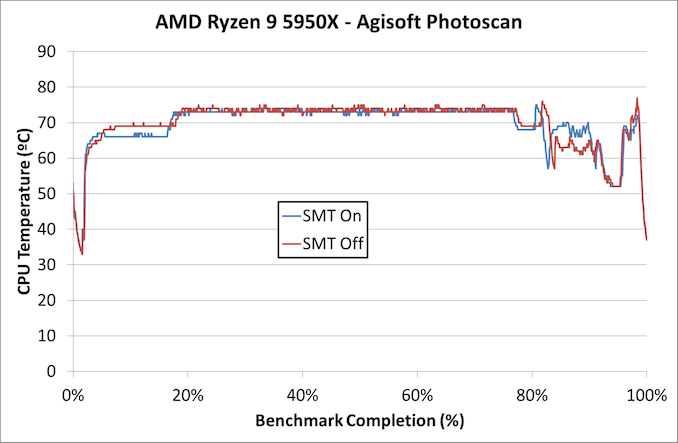
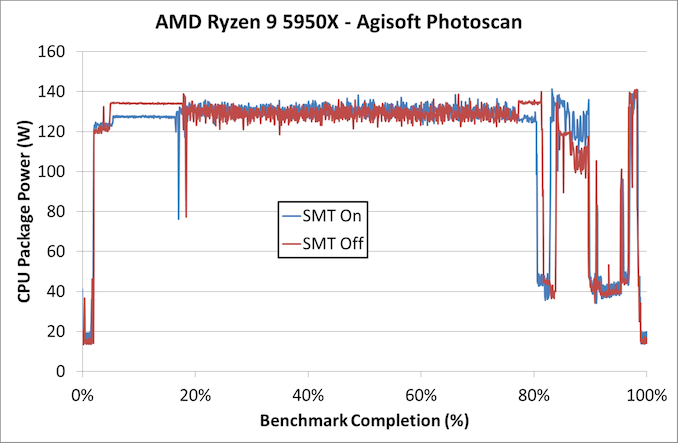
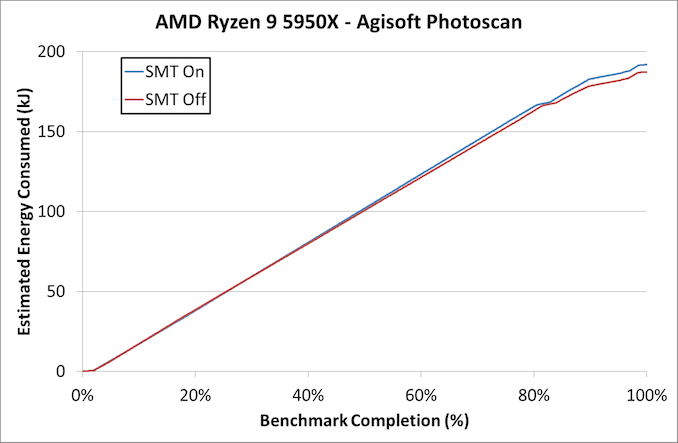
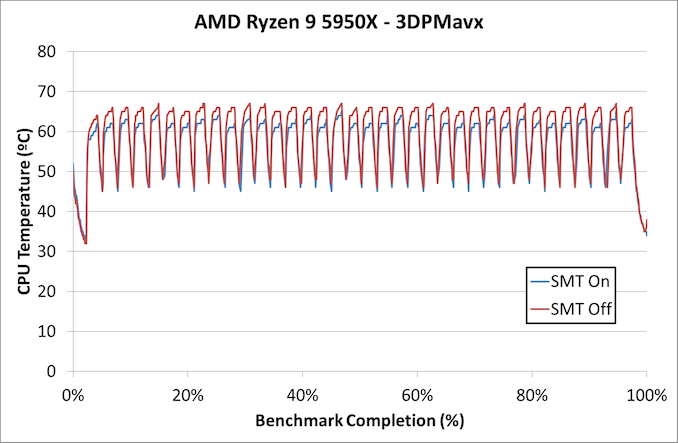
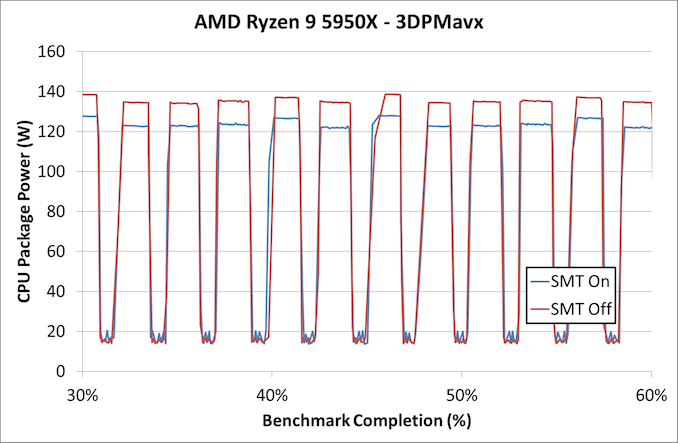
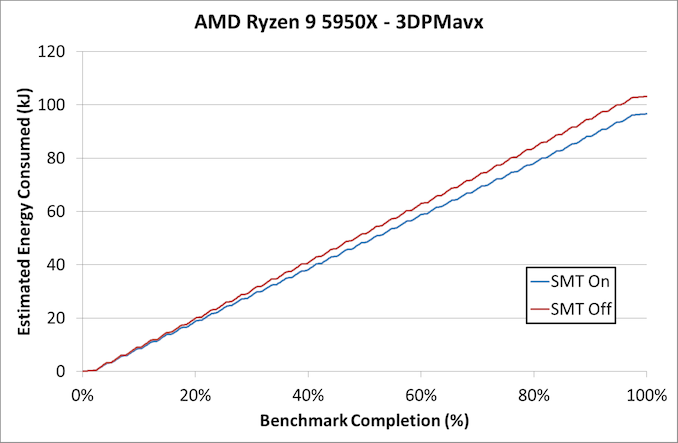








126 Comments
View All Comments
Oxford Guy - Friday, December 4, 2020 - link
Suggestions:Compare with Zen 2 and Zen 1, particularly in games.
Explain SMT vs. CMT. Also, is SMT + CMT possible?
AntonErtl - Sunday, December 6, 2020 - link
CMT has at least two meanings.Sun's UltraSparc T1 has in-order cores that run several threads alternatingly on the functional units. This is probably the closest thing to SMT that makes sense on an in-order core. Combining this with SMT proper makes no sense; if you can execute instructions from different threads in the same cycle, there is no need for an additional mechanism for processing them in alternate cycles. Instruction fetch on some SMT cores processes instructions in alternate cycles, though.
The AMD Bulldozer and family have pairs of cores that share more than cores in other designs share (but less than with SMT): They share the I-cache, front end and FPU. As a result, running code on both cores of a pair is often not as fast as when running it on two cores of different pairs. You can combine this scheme with SMT, but given that it was not such a shining success, I doubt anybody is going to do it.
Looking at roughly contemporary CPUs (Athlon X4 845 3.5GHz Excavator and Core i7 6700K 4.2Ghz Skylake), when running the same application twice one after the other on the same core/thread vs. running it on two cores of the same pair or two threads of the same core, using two cores was faster by a factor 1.65 on the Excavator (so IMO calling them cores is justified), and using two threads was faster by a factor 1.11 on the Skylake. But Skylake was faster by a factor 1.28 with two threads than Excavator with two cores, and by a factor 1.9 when running only a single core/thread, so even on multi-threaded workloads a 4c/8t Skylake can beat an 8c Excavator (but AFAIK Excavators were not built in 8c configurations). The benchmark was running LaTeX.
Oxford Guy - Sunday, December 6, 2020 - link
AMD's design was very inefficient in large part because the company didn't invest much into improving it. The decision was made, for instance, to stall high-performance with Piledriver in favor of a very very long wait for Zen. Excavator was made on a low-quality process and was designed to be cheap to make.Comparing a 2011/2012 design that was bad when it came out with Skylake is a bit of a stretch, in terms of what the basic architectural philosophy is capable of.
I couldn't remember that fourth type (the first being standard multi-die CPU multiprocessing) so thanks for mentioning it (Sun's).
USGroup1 - Saturday, December 5, 2020 - link
So yCruncher is far away from real world use cases and 3DPMavx isn't.pc8086 - Sunday, December 6, 2020 - link
Many congratulations to Dr. Ian Cutress for the excellent analysis carried out.If possible, it would be extremely interesting to repeat a similar rigorous analysis (at least on multi-threaded subsection of choosen benchmarks) on the following platforms:
- 5900X (Zen 3, but fewer cores for each chiplet, maybe with more thermal headroom)
- 5800X (Zen 3, only a single computational chiplet, so no inter CCX latency throubles)
- 3950X (same cores and configuration, but with Zen 2, to check if the new, beefier core improved SMT support)
- 2950X (Threadripper 2, same number of cores but Zen+, with 4 mamory channels; useful expecially for tests such as AIBench, which have gotten worse with SMT)
- 3960X (Threadripper3, more cores, but Zen2 and with 4 memory ch.)
Obviously, it would be interesting to check Intel HyperThreading impact on recent Comet Lake, Tiger Lake and Cascade Lake-X.
For the time being, Apple has decided not to use any form of SMT on its own CPUs, so it is useful to fully understand the usefulness of SMT technologies for notebooks, high-end PCs and prosumer platforms.
Than you very much.
eastcoast_pete - Sunday, December 6, 2020 - link
Thanks Ian! With some of your comments about memory access limiting performance in some cases, how does (or would) a quad channel memory setup give in additional performance compared to the dual channel consumer setups (like these or mine) have? Now, I know that servers and actual workstations usually have 4 or more memory channels, and for good reason. So, in the time of 12 and 16 core CPUs, is it time for quad channel memory access for the rest of us, or would that break the bank?mapesdhs - Thursday, December 10, 2020 - link
That's a good question. As time moves on and we keep getting more cores, with people doing more things that make use of them (such as gaming and streaming at the same time, with browser/tabs open, livechat, perhaps an ecode too), perhaps indeed the plethora of cores does need better mem bw and parallelism, but maybe the end user would not yet tolerate the cost.Something I noticed about certain dual-socket S2011 mbds on Aliexpress is that they don't have as many memory channels as they claim, which with two CPUs does hurt performance of even consumer grade tasks such as video encoding:
http://www.sgidepot.co.uk/misc/kllisre_analysis.tx...
bez5dva - Monday, December 7, 2020 - link
Hi Dr. Cutress!Thanks for these interesting tests!
Perhaps, SMT thing is a something that could drastically improve more budget CPUs performance? Your CPU has more than enough shiny cores for these games, but what if you take Ryzen 3100? I believe %age would be different, as it was in my real world case :)
Back then i had 6600k@4500 and in some FPS games with a huge maps and a lot of players (Heroes and Generals; Planetside 2) i started to receive stutters in a tight fights, but when i switched to 6700@4500 it wasn't my case anymore. So i do believe that Hyperthreading worked in my case, cuz my CPUs were identical aside of virtual threads in the last one.
Would super interesting to have this post updated with a cheaper sample results 😇
peevee - Monday, December 7, 2020 - link
It is clear that 16-core Ryzen is power, memory and thermally limited. I bet SMT results on 8-core Ryzen 7 5800x would be much better for more loads.naive dev - Tuesday, December 8, 2020 - link
The slide states that Zen 3 decodes 4 instructions/cycle. Are there two independent decoders which each decode those 4 instruction for a thread? Or is there a single decoder that switches between the program counters of both threads but only decodes instructions of one thread per cycle?